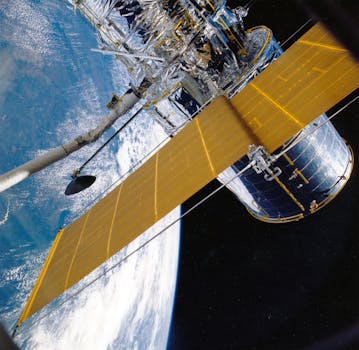The Rise of Mega-Constellations: Latest Updates in Satellite Telecommunications

The Rise of Mega-Constellations: Latest Updates in Satellite Telecommunications
The Rise of Mega-Constellations: Latest Updates in Satellite Telecommunications, the field of satellite telecommunications is undergoing a significant transformation with the emergence of mega-constellations. These constellations, comprising thousands of satellites in low Earth orbit, aim to provide global internet coverage, bridging the digital divide and enabling unprecedented connectivity. In this article, we will delve into the latest updates and developments in the field of mega-constellations, exploring their potential impact on the telecommunications industry and beyond.
Introduction to Mega-Constellations

Mega-constellations are large networks of satellites in low Earth orbit, typically between 160 and 2,000 kilometers in altitude. These satellites are designed to provide high-speed internet connectivity to remote and underserved areas, where traditional fiber-optic infrastructure is often lacking. By leveraging advanced space technology and economies of scale, companies like SpaceX, Amazon, and OneWeb are launching thousands of satellites into orbit, creating a new paradigm for global telecommunications.
One of the primary drivers behind the development of mega-constellations is the growing demand for global internet connectivity. With an estimated 3.8 billion people still lacking access to the internet, the potential market for satellite-based connectivity is vast. Moreover, the COVID-19 pandemic has accelerated the need for remote connectivity, highlighting the importance of reliable and high-speed internet access for businesses, education, and healthcare.
Key Players and Developments

Several companies are at the forefront of the mega-constellation revolution, each with their unique approach and technological advancements. SpaceX, founded by Elon Musk, is one of the pioneers in this field, with its Starlink constellation aiming to provide global internet coverage with a network of over 40,000 satellites. Amazon’s Kuiper Systems is another notable player, with plans to launch over 3,000 satellites into orbit, while OneWeb has already launched several hundred satellites as part of its constellation.
Recent developments have seen significant advancements in satellite technology, including the use of phased arrays, advanced propulsion systems, and 3D printing. These innovations enable the production of smaller, more efficient, and cost-effective satellites, making mega-constellations a more viable and affordable option for global connectivity.
Challenges and Controversies

Despite the promise of mega-constellations, several challenges and controversies surround their development and deployment. One of the primary concerns is the potential for space debris, as thousands of satellites are launched into orbit, increasing the risk of collisions and environmental harm. Regulatory frameworks are still evolving to address these concerns, with the need for standardized guidelines and international cooperation to ensure sustainable and responsible satellite operations.
Additionally, the impact of mega-constellations on astronomy and the night sky has sparked debate among scientists and astronomers. The sheer number of satellites in orbit could potentially interfere with astronomical observations, while also contributing to the problem of light pollution. As the industry continues to grow, it is essential to address these concerns and develop strategies to mitigate the effects of mega-constellations on the environment and scientific research.
Conclusion and Future Outlook

In conclusion, the rise of mega-constellations is transforming the field of satellite telecommunications, offering unprecedented opportunities for global connectivity and internet access. While challenges and controversies surround their development, the potential benefits of mega-constellations are undeniable. As the industry continues to evolve, it is crucial to address the concerns surrounding space debris, regulatory frameworks, and environmental impact, ensuring a sustainable and responsible approach to the deployment of mega-constellations.
See more:





